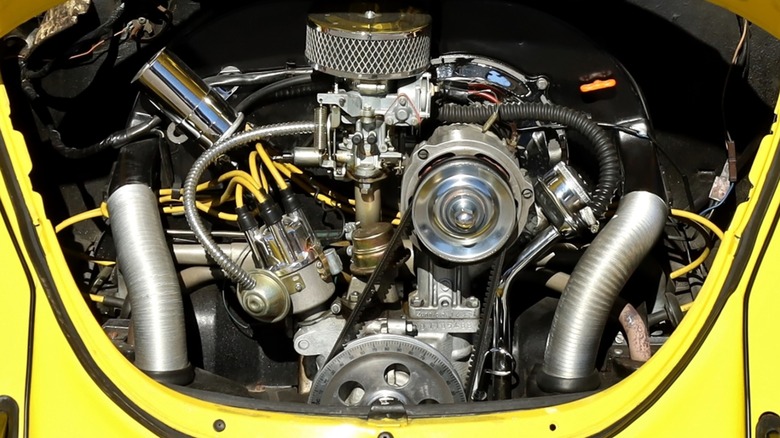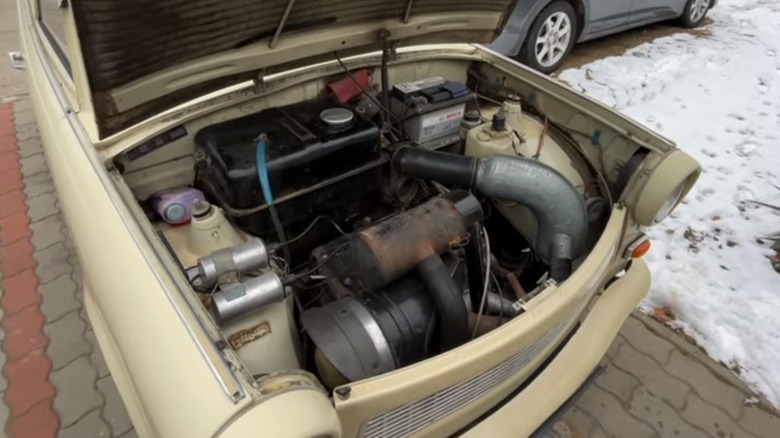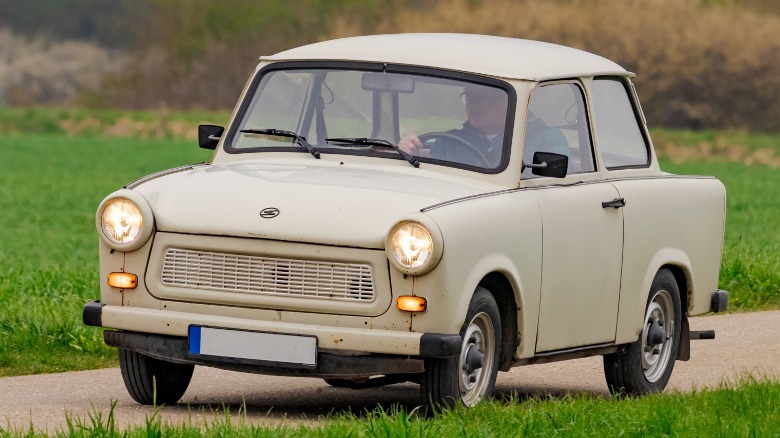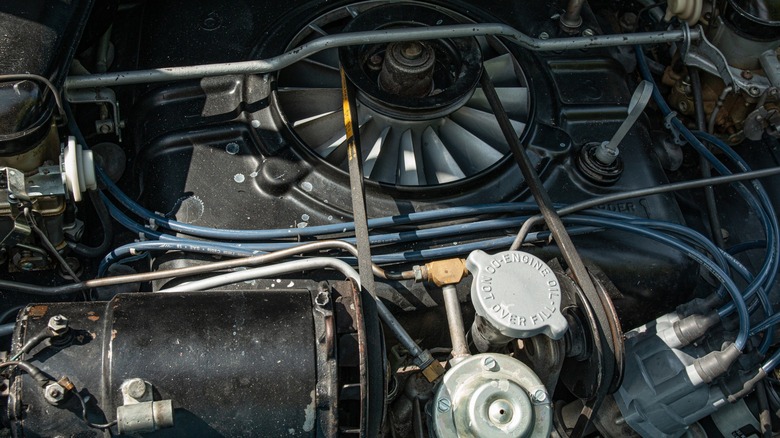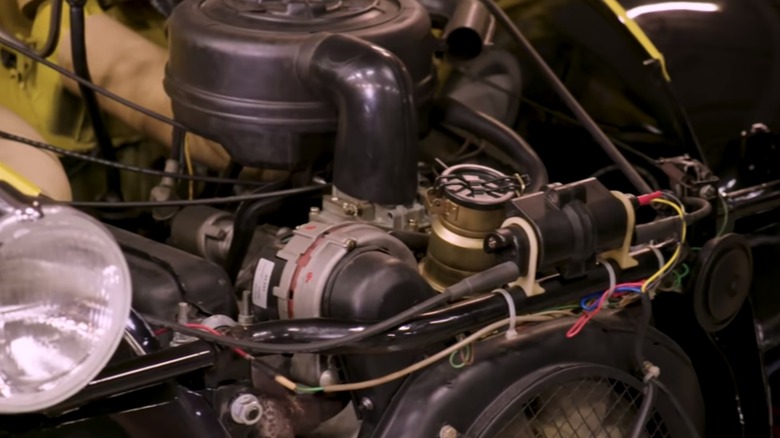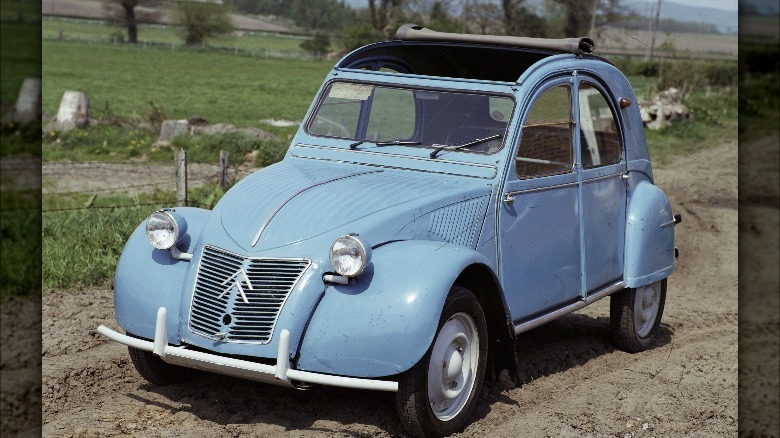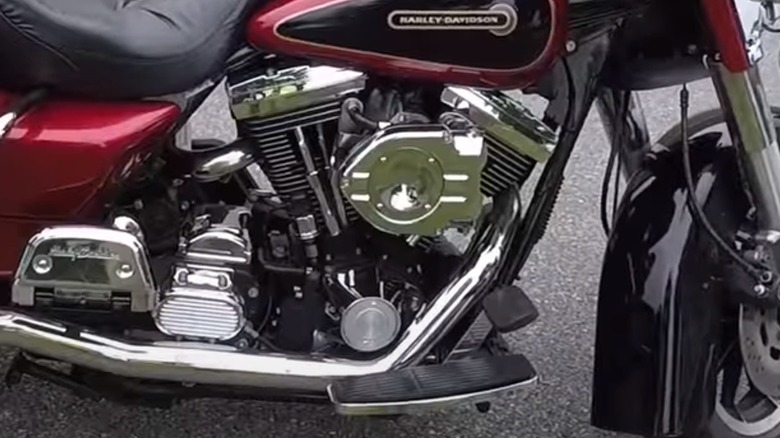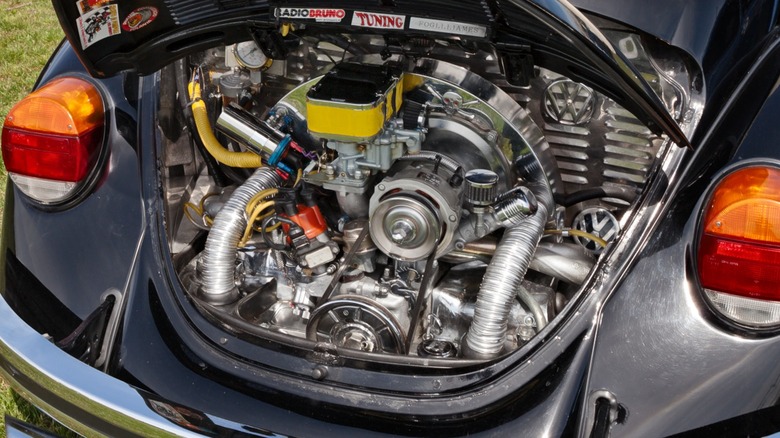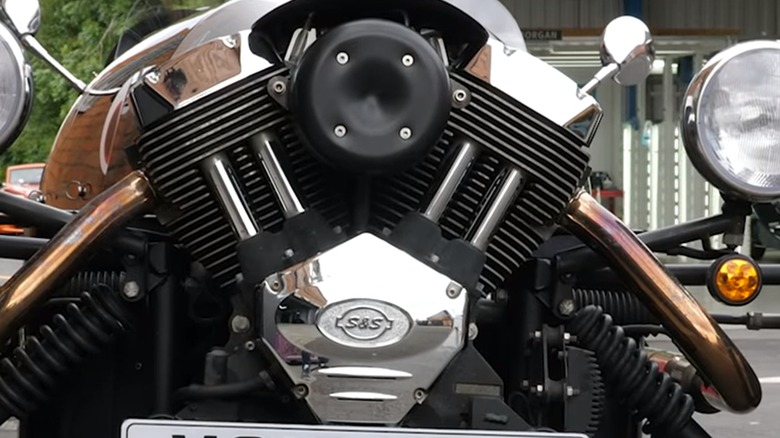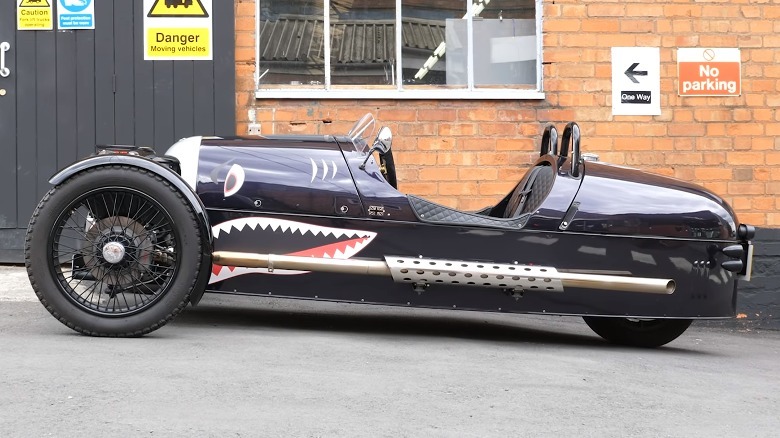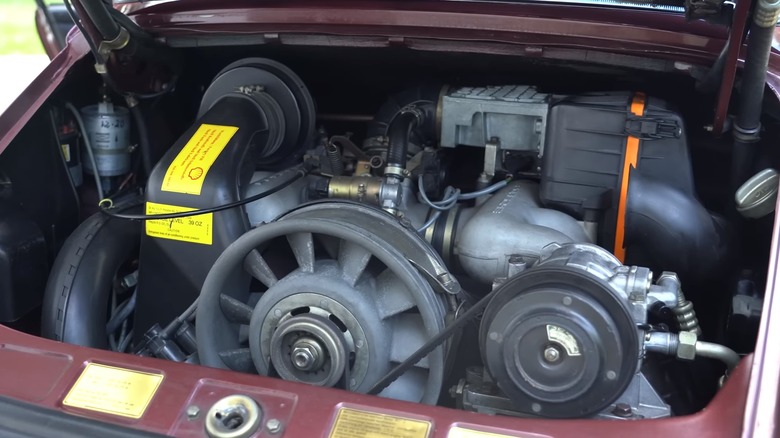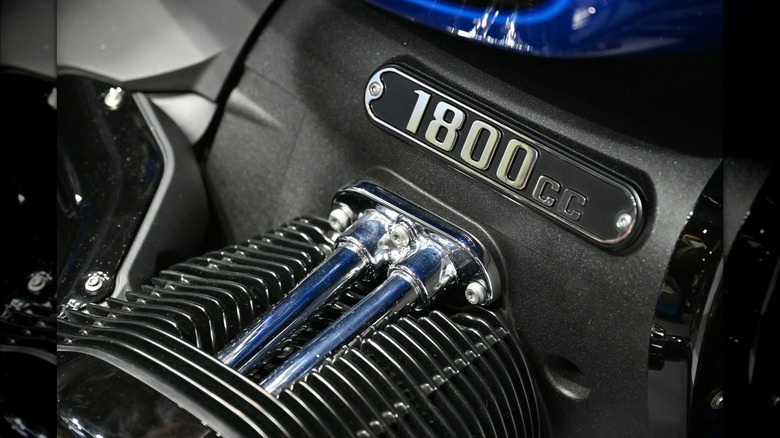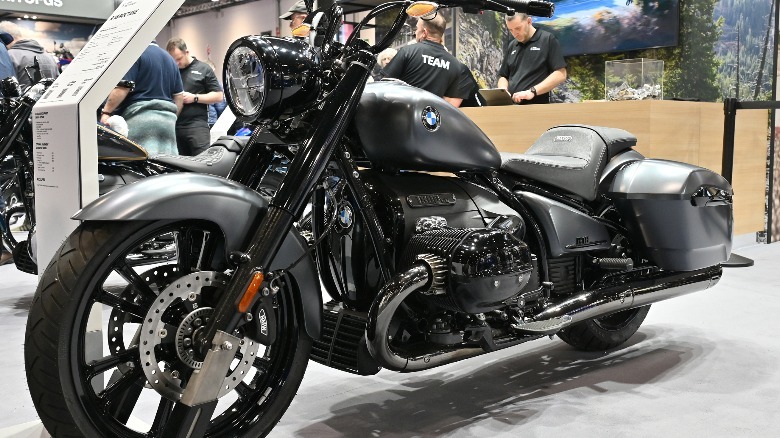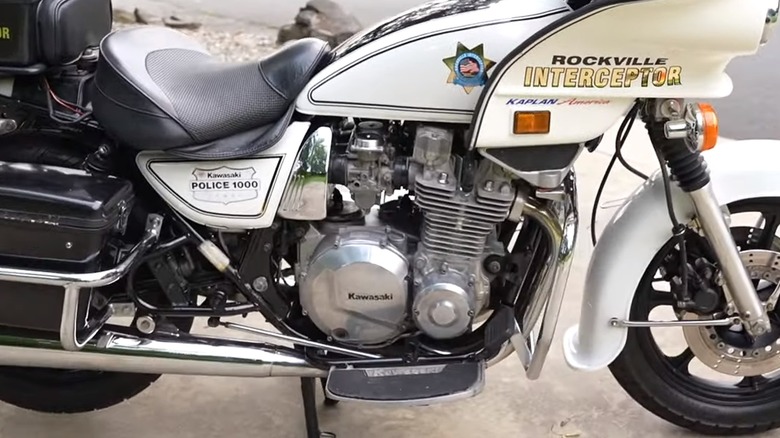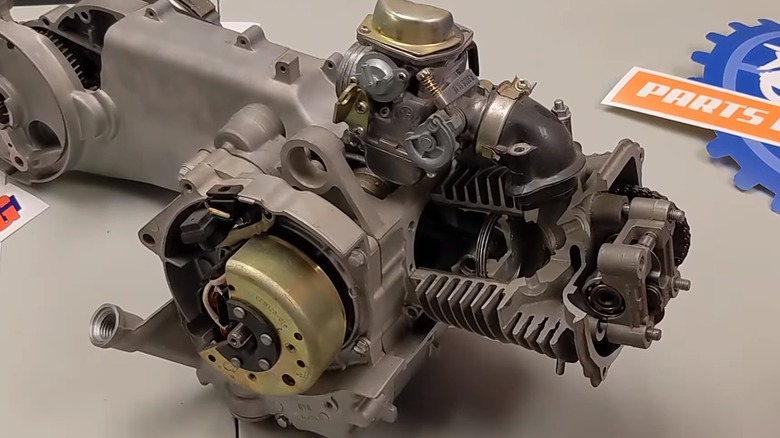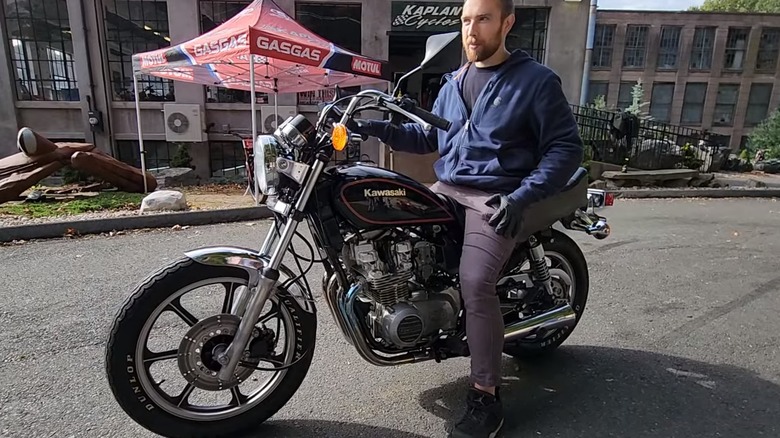10 Of The Most Reliable Air-Cooled Engines Ever Made, Ranked
If you are not at least moderately informed about how engines work, you may still be aware that they all require water, or antifreeze, in order to function. It is true that some form of coolant is required to keep engines from overheating, but for some engines, the cooling is performed using air. Air-cooled engines feature cooling fins extending from the side of the cylinders and heads to help dissipate heat by having fast-moving air passed over them, and this can be done either by using a fan in a forced-air cooling system or by using the air naturally passing over the engine from being exposed as it travels.
Air-cooled engines once saw use in passenger cars, although it was never widespread. No modern cars or trucks use air cooling mostly because of emissions regulations. Because the cooling of the engine never stops, they take longer to heat up and produce more harmful emissions during this period of warming. Furthermore, the amount of power possible is limited because more power creates more heat and the ability to dissipate heat is greatly increased when introducing a water cooling system. However, lacking the plumbing, pump, and various seals of water cooling, air-cooled engines are often robust and reliable. Therefore, looking back through the archives of production engine catalogs, these are the most reliable air-cooled engines ever made for production cars or motorcycles, beginning with the least reliable.
Trabant 601 twin-cylinder
Before the Iron Curtain fell in East Germany, there was Trabant, a state-run automaker producing woefully outdated cars from a woefully lacking availability of resources. In 1957, the East Germans introduced this car as a counterpart to the West German VW Beetle. It was a simple car meant to be easy to operate and maintain much like its West German counterpart. But even in 1957, it made the Beetle look like a paragon of sophistication. This is in part because the fuel tank is located under the hood and lacks a gauge, but the engine can probably take the most credit for the car's inadequacy.
Few design or mechanical changes came to the Trabant in 40 years of production. Trabis, as they were called, are powered by a 600cc 2-cylinder air-cooled 2-stroke engine. With just 18 horsepower, a Trabi might make it to 60 mph. It's smoky and obnoxious little engine with minimal power that produces significantly more pollution than anything on the road today.
Despite its shortcomings, the Trabi's engines are remarkably reliable, even if the car around them was held together by nothing but hope and sheer will. With only a few moving parts — two-strokes lack complex valvetrains — there are fewer to break. Since there was no East German Consumer Reports, reliability has to be drawn from anecdotes, but modern owners credit the simplicity of the engine for its generally good reliability, so long as you always add oil to the fuel.
Chevrolet Corvair flat-6
Despite being famously panned by Ralph Nader in his book, "Unsafe At Any Speed," Chevrolet managed to sell tens of thousands of its air-cooled VW Beetle-fighting Corvairs between 1960 and 1969. The popularity of the German import led Chevrolet to create an American-style "people's car" complete with an air-cooled engine in the rear with, unlike the Beetle, ample seating and a reasonable trunk space up front.
The engine is unique for General Motors as it is the only air-cooled horizontally-opposed engine ever made by the company, and the only rear-engine car produced by GM. The engine design was meant to be cheap to manufacture and allowed for an inexpensive way to give the car independent rear suspension. To pull it off, GM engineers had to incorporate several new technologies in the use of alloys, fuel delivery, and even drive belts. The result was an ingeniously designed engine that worked well in this application without being too costly to build.
Contemporary reliability testing is hard to come by these days. In 1962, Motor Trend and other prominent publishers of the day gathered at Riverside International Raceway to endurance test a pair of Corvairs. While a couple of minor issues had to be contended with, they suffered no serious problems during the 24 hours of driving time. More recent anecdotes from Corvair owners' forums using them as daily drivers suggests that the engines are dependable but will first need to be properly tuned, with maintenance kept up after that.
Citroën twin
After WWII, France, which had been devastated, needed to get its economy and people back on the move. Having limited resources while building a car for people with limited incomes, Citroën came up with the brilliant 2CV. Plans for this car actually pre-dated the war, but they had to be hidden, including tooling and prototypes, from the Nazis during occupation. It was not until 1949 that the new car could be produced.
Much of this car's ingenuity is tied to its chassis and suspension, and the lightweight and simple bodywork. The engine powering the diminutive car was initially a 375cc air-cooled horizontally opposed twin making just 9 horsepower. The first models featured a pull cord starter akin to those on lawnmowers but would soon be replaced by an electric version. Engine size and corresponding power increased through its 42 years of production to a 602cc unit with up to 33 horsepower.
As it was built for a very affordable car, the 2CV engine is incredibly simple, using only a handful of parts to assemble. It also features clever designs to remain reliable. The spark plugs fire together on every power and exhaust stroke, eliminating the need for a distributor, and the cooling fan is driven directly from the crankshaft. Heads and cylinders were precision machined to fit without a gasket, eliminating another failure point. While some trouble spots can appear, including a plugged oil cooler, few common problems with this engine exist.
Harley-Davidson Evolution V-Twin
For over a century, Harley-Davidson has been the representation of the free American spirit in mechanical form. The air-cooled V-twin engine powering Harleys has come to define American motorcycles. The air-cooled V-twin that has been the brand's staple engine is a relatively simple design, and those made by Harley are known for producing a lot of torque at low rpm rather than high horsepower at the top of the range, which is what makes it ideal for a big highway cruiser over a super fast sport bike.
Those who follow Harley-Davison are likely aware of the period in which the motorcycle manufacturer was owned by a company popularly associated with bowling equipment, AMF. This period is notable for its severe decline in quality. After AMF sold the company, quality eventually recovered, particularly with the introduction of the Harley-Davidson Evolution V-twin, which is often grouped among reliable motorcycle engines.
Introduced in 1983, the 80-cubic-inch twin brought many improvements such as using aluminum for the cylinder and heads with alignment dowels to keep them all in place, preventing leaks. Using extra long head bolts going through the cylinders and holding to the block along with updated piston materials and designs further improved cooling and durability. Feedback from Harley owners on forums suggest that early machines had issues with the crankcase and lifters that later machines did not experience, and many develop cracks between the valves and spark plugs. Otherwise, they prove to be long lasting machines with proper upkeep.
Volkswagen flat-4
The Volkswagen Type 1 "Beetle" is an iconic vehicle that had a lasting impact on popular culture. Kids today likely recognize a VW Beetle instantly while knowing nothing of Studebaker, despite its history of building American automobiles and wagons for more than a century. Powering the Beetle and a handful of other early VW autos was an equally iconic air-cooled horizontally-opposed 4-cylinder engine.
The original VW engine, which was in production for decades, is air-cooled for low-cost manufacturing and incorporates several features to make it cheap and easy to own, such as using a low-compression design, allowing it to run on fuels of any quality. The flat-4 design also makes it easy to assemble and service. Each cylinder is an aluminum barrel that can be replaced individually and prevents issues in which an engine failure can ruin the entire engine.
The simplicity of VW engines makes them inherently reliable, although weak spots related to the oil cooler can lead to valve or piston failures. In 1968, the VW air-cooled 4-cylinder engine became the first to offer electronic fuel injection in a mass production vehicle, providing more power while eliminating delicate carburetor tuning. Modern VW forum users explain that they are known to last an incredibly long time but require regular maintenance to ensure reliable operation. A lack of preventative work can lead to many frustrations. But according to those still keeping these on the road, air-cooled VW engines can be dependable machines.
S&S V-Twin
For many years, builders of custom Harley-Davidson motorcycles have had the option of installing a completely different engine from S&S. This company began in the late '50s offering performance upgrades for Harley products, eventually expanding its product offerings until it created its own V-twin engine, released in 1993.
S&S have never mass-produced complete motorcycles, sticking with engines and performance parts instead. However, this has never slowed the company down as it continues to provide robust V-twin engines to custom builders and Harley owners looking for an upgrade. This has proven to be a profitable venture as S&S engines not only provide more power than stock Harley blocks, they also improve reliability.
In addition to being replacements for Harley-Davidson engines, S&S has supplied for many years engines to Morgan. Although the most recent Morgan Super 3 uses a water-cooled Ford 3-cylinder for its 3-wheeled car, models made from 2011 used an original design S&S X Wedge V-twin. Though its air-cooled design dates back many years, the fuel-injected engine is thoroughly modern. A Wired review claims the engine to be "bulletproof" while Pistonheads warns only of minor oil seepage, hardly anything to compromise reliability. The takeaway is that whether your S&S drives two wheels or three, you should expect it to do so dependably.
Porsche flat-6
The association with air-cooled engines for Porsche goes straight back to the roots of the company and its first production car, the 356. While the first cars used modified VW engines, they would soon take off in a high-performance direction and never look back. In 1963, Porsche introduced a new 901 model, although it was soon changed to 911. It also presented a Porsche staple for decades, the air-cooled flat-6 engine.
Since its introduction, the 911 morphed into a great driving sporty car to an all-out track monster, capable of using its 6-cylinder engine to beat sophisticated V8 and V12 models. All the while, every Porsche engine remained cooled by the atmosphere until the first water-cooled car came along in 1997. However, there is a partial exception as the amazing Porsche 959 supercar used water-cooled heads to keep temps down on its 450-horsepower flat-6.
Unsurprisingly, parts and repairs for Porsche vehicles are expensive. It is a high-end performance car full of precision engineering. However, it may be surprising to many that Porsche engines are mostly reliable machines that do not succumb to the finicky nature of exotic supercars. Motor Trend asked Porsche experts for advice on buying an air-cooled Porsche and found broad consensus that the 993 and 964, built from 1989 to 1998, are well-built and reliable cars. Cars.com reviewers give the 1995 911 4.9/5 stars, with glowing reviews for both performance and reliability.
BMW Boxer Twin
BMW is well-known for its high-performance luxury cars, but it has been making excellent motorcycles for just about as long. Since 1923, motorcycles featuring the BMW roundel and boxer twin engines have been a staple of the German transportation industry, and the 1936 BMW R12 is an icon of classic motorcycles. While it has produced bikes with singles and triples both air and water-cooling, the air-cooled boxer has been a staple and is still offered today.
Most of BMW's current lineup consists of water-cooled bikes, but its heritage line continues to use air cooling. This includes the R18, R12, and R nineT in various configurations with either a 1200cc or 1800cc engine. What you get with any of these bikes is a thoroughly modern engine featuring fuel-injection and four valves-per-cylinder, although no overhead cams. It is electronically controlled using the latest in engine management while retaining a classic look familiar to BMW motorcycles from the past.
Overall, BMW motorcycles rate favorable for reliability, although they lag behind many Japanese models. They can last a long time, although upkeep and maintenance must be kept current. Motorcycle News gives the R18 Classic 3.7/5 for reliability while Motorcyclist praises the engine's performance but is a bit soured by frequent valve adjustments. BikeSocial also praises the reliability of the R nineT Pure. Like many other high-end driving machines, they require proper care with regular check-ups, and with that, they will provide years of riding enjoyment.
Kawasaki 1000
Motorcycle manufacturer Kawasaki has for decades been known for making good motorcycles, and was even the first Japanese manufacturer to open an American production facility in 1974. It has been a leader in its field ever since, releasing many best-selling models such as its Ninja sportbikes. While many of its bikes today are water-cooled, it built its reputation with air-cooled machines.
One of Kawasaki's most enduring models in the United States was based on its popular KZ1000 motorcycle, but remained in production for years after that bike was retired in 1984. The Kawasaki Police 1000, or KZP, was a prominent choice of police departments all over the country from its introduction in 1978 until its retirement in 2005. That this bike was kept in production for 20 years after the consumer model was discontinued should be proof enough that it was well-liked and dependable enough for police service.
Back in 1979, Cycle World wrote that the 7-year-old 100cc engine was still as good as ever, noting that with the then-new emission controls, it had not lost any power while cleaning up the exhaust. In looking to buy a vintage KZ650, which is fundamentally similar to the KZ1000, Revzilla's only significant caution is to check valve cover gaskets and end seals for leaks, suggesting major mechanical components remain robust decades later. Does this mean the Kawasaki 1000cc engine is perfect? No, but for a classic air-cooled bike, it gets pretty close.
Honda GY6
Few have ever heard of a Honda GY6 engine. However, readers outside of North America are much more likely to be familiar with it. Although there is not a consensus on its origin, the prevailing story is that Honda developed the GY6 engine in the '80s. Regardless, the single-cylinder engine, made in sizes from 50cc to 300cc, has been cloned by many manufacturers and sold all over the world.
The widespread use of the GY6 design is for good reason. It is simple and robust, and with a single overhead cam operating just two valves and a hemispherical combustion chamber. The clutch is centrifugal and engages a belt-driven constant velocity transmission, making scooters as easy as twisting the throttle to ride. People like the GY6 because it is easy to service. All the parts are easily accessible and it can be removed from a scooter with little effort.
While reliability of cheap scooters imported from China can be shocking, a look at Kymco scooters, most of which use GY6 engines, from Taiwan can be a better gauge. A look at Cycle Insider lists 63 reviews, garnering Kymco a 4.9/5 stars, with many owners gushing over the dependability, and Motorcycle.com shows similar results for ratings of more than 200 Kymco models. After all, the millions of scooter riders all over Asia can't all be wrong.
Why are these the best?
With air-cooled engines being obsolete in cars and used in fewer motorcycles than ever, good information about reliability can be hard to come by. Much of what is available can be gleaned only from anecdotes or articles written years ago when technology was completely different. Other sources are user reviews and public comments on the internet, both of which can be highly informative but ultimately not entirely unbiased. Therefore, these engines are assembled and ranked earnestly and with good intentions — even though some will likely disagree with our assessment. But that is okay as this list of air-cooled engines is meant to be light-hearted, informative, and, hopefully, interesting, especially since some of these are not readily available to buy these days, and using this list as a genuine buying guide would be folly.
